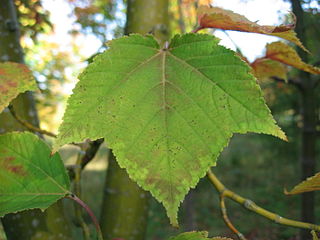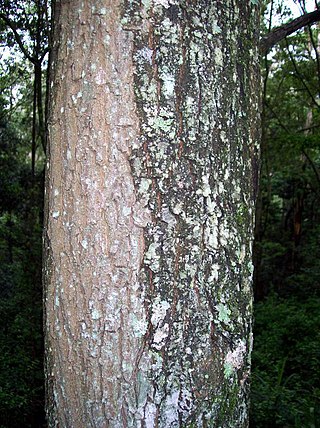
Viburnum lentago, the nannyberry, sheepberry, or sweet viburnum, is a species of Viburnum native to North America.

Aristotelia serrata, commonly known as wineberry or in the Māori language makomako or just mako, is a small tree in the family Elaeocarpaceae, in the genus Aristotelia, found in the North Island, South Island and Stewart Island of New Zealand. It is a small deciduous fast-growing tree or shrub. The tree can reach up to 10m tall, with a trunk diameter up to 30 cm. The bark is pale brown, smooth and patterned with flat lenticels. Branches are long, slender and spreading, branchlets have a reddish-brown colour when pubescent.

Ilex crenata, also known as Japanese holly or box-leaved holly, is a species of flowering plant in the family Aquifoliaceae, native to eastern China, Japan, Korea, Taiwan, and Sakhalin.

Cornus mas, commonly known as cornel, is a species of shrub or small tree in the dogwood family Cornaceae native to Western Europe, Southern Europe, and Southwestern Asia.

Elaeagnus multiflora, the cherry elaeagnus, cherry silverberry, goumi, gumi, or natsugumi, is a species of Elaeagnus native to China, Korea, and Japan.

Acer rufinerve, the grey-budded snake-bark-maple, redvein maple or Honshū maple, is a species of tree in the snakebark maple group, related to Acer capillipes. It is native to mountain forests of Japan, on Honshū, Kyūshū and Shikoku.

Corymbia polycarpa, also known as long-fruited bloodwood or small-flowered bloodwood, is a species of tree that is endemic to northern Australia. Indigenous Australians of different language groups have different names for the tree. The Nungali peoples know the tree as narrga or gunjid, the Mulluk-Mulluk know it as dawart, the Yangman know it as bodog, the Gurindji peoples as jadburru and the Wagiman as jagatjjin. It is a medium-sized tree with rough, tessellated bark on the trunk and branches, lance-shaped to curved adult leaves, flower buds in groups of seven or nine, white or cream-coloured flowers and barrel-shaped fruit.

Ilex latifolia is a species of holly, native to southern Japan and eastern and southern China, growing in broadleaf forests at altitudes of 200–1,500 m.

Mangifera zeylanica or "Sri Lanka wild mango" is a wild species of mango tree endemic to Sri Lanka. This stately tree is the tallest member of the mango genus, Mangifera, and one of the two tallest trees in the family Anacardiaceae. The mango fruits are edible and have an excellent taste. It is called "aetamba" (ඇටඹ) or "wal amba" in Sinhala and “kaddu-ma” in Tamil. The well-known British botanist and explorer Joseph Dalton Hooker first described the tree in 1876.

Ehretia acuminata is a deciduous tree found in Japan, China, Bhutan, Nepal, Laos, Vietnam, New Guinea and Australia. Fossil evidence suggests an ancient Laurasian origin. This group of plants spread to Australia and South America via Africa, when these continents were still joined.

Brachychiton discolor is a rainforest tree of eastern Australia. It grows in drier rainforest areas. Scattered from Paterson, New South Wales to Mackay, Queensland. There is also an isolated community of these trees at Cape York Peninsula.

Rhodosphaera is a genus of plants in the family Anacardiaceae. The genus includes a single species, Rhodosphaera rhodanthema, which is a rainforest tree of eastern Australia. It grows in sub tropical rainforests and also in the drier form of rainforests. The natural range of distribution is from the Macleay River, New South Wales to Maryborough in south east Queensland. Common names include deep yellowwood, yellow cedar and tulip satinwood.

Elattostachys nervosa, known as the green tamarind or beetroot tree is a common rainforest tree of eastern Australia. Found in all types of rainforest, growing from Paterson, New South Wales in the south to Gympie in south east Queensland. The name Elattostachys refers to "little spikes", a flower feature of other plants in this genus. Nervosa refers to the prominent leaf venation. Beetroot Tree refers to the beetroot red leaves of the new growth.

Mallotus philippensis is a plant in the spurge family. It is known as the kamala tree or red kamala or kumkum tree, due to the fruit covering, which produces a red dye. However, it must be distinguished from kamala meaning "lotus" in many Indian languages, an unrelated plant, flower, and sometimes metonymic spiritual or artistic concept. Mallotus philippensis has many other local names. This kamala often appears in rainforest margins. Or in disturbed areas free from fire, in moderate to high rainfall areas.

Bridelia exaltata, known as the brush ironbark or scrub ironbark, is a tree of eastern Australia. It occurs in and on the margins of the drier rainforests. Also occurring by streams, often in association with the Black Bean, up to an elevation of 600 metres above sea level. It occurs from Seal Rocks, New South Wales to Maryborough, Queensland.

Alangium polyosmoides is a rainforest tree of eastern Australia. It occurs on a variety of different soils, generally close to the coast. Found from Minmi near Newcastle to as far north as the McIlwraith Range in far north eastern Australia. It may be seen as a common understorey plant at Wingham Brush Nature Reserve.

Petalostigma triloculare, known as the long-leaved bitter bark is a rainforest tree of eastern Australia. It occurs in the drier rainforests, often on sandy soil derived from granite or sandstone, and is sometimes seen on old sand dunes.

Laurus novocanariensis is a large shrub or tree with aromatic, shiny dark-green foliage. belonging to the evergreen tree genus Laurus of the laurel family, Lauraceae. The genus includes three species, whose diagnostic key characters often overlap. Under favorable conditions it is an impressive tree of 3 to 20 m. tall. It is native of rich soils in the cloud zone of always moist spots in subtropical climate with a high air-humidity, on the Canary and Madeira islands.

Diospyros dichrophylla (Gand.) De Winter is a Southern African tree belonging to the ebony family of Ebenaceae and closely related to the Persimmon.

Barringtonia edulis is a species of tree with edible fruits from the southwestern Pacific region, being found on Fiji and Vanuatu. Common names include cut nut, pao nut, boxfruit tree, heart tree, and yum-yum tree.
























